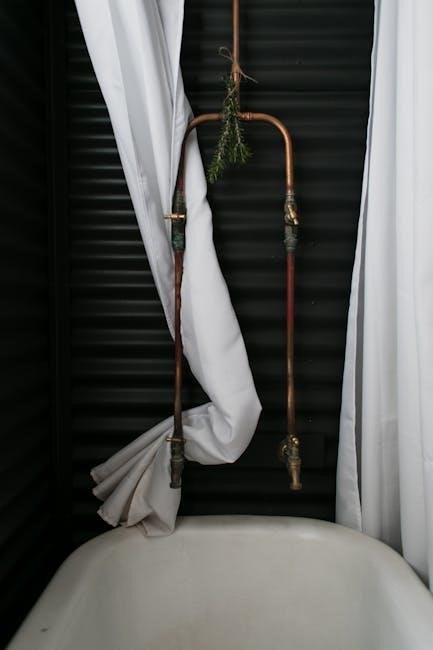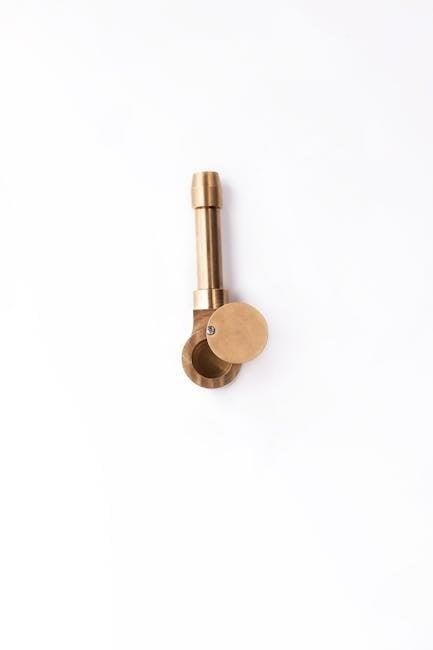
copper pipe size chart pdf
Copper Pipe Size Chart PDF: A Comprehensive Guide
This guide provides a detailed exploration of copper pipe dimensions. It offers essential information in a convenient, downloadable PDF format. It covers nominal and actual sizes.
Understanding copper pipe dimensions is crucial for various plumbing, HVAC, and industrial applications. Accurate measurements ensure proper fitting and functionality. This section introduces the key aspects of copper pipe sizing, focusing on nominal size, outside diameter (OD), and wall thickness. Copper pipes are available in various types, each with specific dimensional characteristics suitable for different uses. The dimensions are standardized, but variations exist between types such as K, L, M, and DWV. Knowing these differences ensures selection of the appropriate pipe for the intended application. A copper pipe size chart provides a quick reference for these dimensions, aiding in efficient project planning and execution. This introduction will set the foundation for interpreting these charts effectively.

Understanding Copper Pipe Types
Copper pipes are categorized into types K, L, M, and DWV. Each type has unique wall thicknesses, affecting their pressure ratings and applications. Understanding these differences is essential for appropriate selection.
Type K Copper Pipe
Type K copper pipe boasts the thickest wall compared to Types L and M, rendering it suitable for demanding applications. It’s commonly employed underground, for potable water distribution, fire protection systems, and HVAC. Its robust construction ensures durability and resistance to high pressure. Type K copper is often used in commercial and industrial settings where reliability is paramount. The heavier wall thickness contributes to its longevity and ability to withstand harsh conditions. Its availability in both rigid and flexible forms provides versatility for diverse installation needs. Refer to the PDF size chart for detailed dimensions. Remember to consider temperature control when selecting. Always consult local codes before installation. Copper’s inherent resistance to corrosion makes Type K a dependable choice. Proper fitting and joining techniques are essential to maintain system integrity. Selecting the right pipe type is crucial for optimal performance and safety.

Type L Copper Pipe
Type L copper pipe presents a balance between durability and cost-effectiveness, making it a popular choice for various plumbing applications. It’s frequently utilized for interior water distribution, fire sprinkler systems, and some HVAC setups. Its medium wall thickness provides adequate strength for most residential and light commercial uses. Compared to Type K, it is lighter and more economical, while still offering good corrosion resistance. Type L copper is available in both rigid and flexible forms to accommodate different installation requirements. Check the copper pipe size chart PDF for precise dimensions and specifications. Ensure compatibility with fittings and joining methods. Remember to adhere to local plumbing codes and regulations. While suitable for many applications, it may not be ideal for high-pressure or highly corrosive environments. Proper installation practices are essential for long-term performance. Always consider the specific needs of your project when selecting the appropriate copper pipe type. A comprehensive understanding of dimensions is key to proper installation.
Type M Copper Pipe
Type M copper pipe is recognized as the thinnest and generally most affordable option among rigid copper pipes. It is commonly used in residential plumbing systems for water distribution. Due to its reduced wall thickness, it is not suitable for high-pressure or industrial applications. Type M copper is typically used in applications where code permits and where the water is not highly acidic. Consult local plumbing codes to ensure its acceptability in your region. When working with Type M copper, precise measurements and proper joining techniques are crucial to prevent leaks. Review the copper pipe size chart PDF for accurate dimensions and specifications. While cost-effective, Type M should only be used in appropriate environments. Its lighter weight makes it easier to handle and install. However, its thinner walls make it less resistant to physical damage. Consider all factors before selecting Type M for your plumbing project. Proper support is important to prevent sagging or bending. Type M offers an economical solution for specific applications.
DWV Copper Pipe
DWV copper pipe, short for Drain, Waste, and Vent, is specifically designed for non-pressure applications. It’s typically used in plumbing systems to remove waste and wastewater. Unlike Type K, L, or M, DWV copper isn’t intended for potable water supply lines. Its primary function is to vent gases and drain waste effectively. DWV copper pipe is often thinner than other types of copper piping, making it a cost-effective solution for drainage systems. Check the copper pipe size chart PDF to confirm dimensions and wall thicknesses. Proper installation is crucial to prevent leaks and ensure efficient drainage. Always consult local plumbing codes to verify the acceptability of DWV copper in your region. When connecting DWV copper, use appropriate fittings and soldering techniques. Ensure the system is properly sloped to facilitate gravity-driven drainage. Regular inspections can help identify potential issues early on. DWV copper offers a reliable and durable solution for waste and vent systems. Its corrosion resistance is vital for long-term performance. Choose the correct size based on fixture unit calculations. Proper ventilation is key to preventing sewer gas buildup.

Key Dimensions in Copper Piping
Understanding key dimensions like nominal size, outside diameter (OD), and wall thickness is critical. These measurements determine proper fitting selection and system performance, as detailed in copper pipe size charts.
Nominal Size vs. Actual Size
In the world of copper piping, it’s crucial to understand the difference between nominal size and actual size. Nominal size is a “name” for the pipe. It is used for easy identification, while the actual size refers to the true measurements of the pipe’s inner and outer diameters.
The nominal size doesn’t directly correlate with any specific dimension. The actual outside diameter will be slightly larger. This discrepancy can lead to confusion if not properly understood. For example, a “1/2 inch” copper pipe doesn’t actually measure 1/2 inch on either its inside or outside.
Always consult a copper pipe size chart PDF to determine the precise dimensions for accurate fittings and connections.
Outside Diameter (OD)
The outside diameter (OD) is a critical dimension when working with copper pipes. It refers to the measurement from one external surface of the pipe to the opposite external surface, essentially the pipe’s overall width. Accurate OD measurements are essential for ensuring proper fitting and connection with other plumbing components.
Unlike nominal size, which is an approximate reference, the OD is a precise measurement. It directly impacts the compatibility of fittings like couplings, elbows, and tees. Copper pipe size charts typically list the OD alongside the nominal size.
Referencing a comprehensive copper pipe size chart PDF is vital for determining the correct OD. This ensures a secure and leak-free plumbing system. Variations in OD can lead to improper seals and potential failures.
Wall Thickness
Wall thickness is a crucial characteristic of copper pipes, significantly impacting their strength and durability. It refers to the measurement of the copper material from the inner to the outer surface of the pipe. Thicker walls generally indicate a higher pressure rating and increased resistance to physical damage.
Different types of copper pipes, such as Type K, Type L, and Type M, are distinguished by their wall thickness. Type K has the thickest walls, followed by Type L, and then Type M, making them suitable for varying applications.
Understanding wall thickness is essential for selecting the appropriate copper pipe for a specific job. Consult a copper pipe size chart PDF to determine the wall thickness for different nominal sizes and pipe types. This ensures optimal performance and longevity of the plumbing system.

Copper Pipe Size Chart Details
This section delves into the specifics found within a typical copper pipe size chart. It covers standard and metric sizes and corresponding dimensions. It will help you select the right pipe.
Standard Sizes and Dimensions (Inches)
Understanding standard copper pipe sizes in inches is crucial for plumbing and HVAC projects. Charts typically list the nominal size, which differs from the actual outside diameter. For example, a “1/2 inch” copper pipe doesn’t actually measure 0.5 inches in outer diameter. Instead, you’ll find the actual OD is larger. The chart will also provide the wall thickness for different types of copper, like Type K, L, and M.
These variations in wall thickness affect the pipe’s pressure rating and suitability for specific applications. The dimensions are presented in inches, as this is the standard measurement in the USA. A size chart details the relationship between the nominal size, actual outside diameter, and wall thickness. It is important to always have this information when working with copper pipes;
Metric Sizes and Dimensions (mm)
For international projects or those utilizing metric measurements, understanding copper pipe dimensions in millimeters (mm) is essential. Metric charts detail the outside diameter and wall thickness of copper pipes, providing alternatives to the standard inch-based system. These charts are crucial for ensuring compatibility with equipment and fittings manufactured using metric standards. Common metric sizes range from small diameters, like 4mm used in specialized applications, to larger sizes exceeding 100mm for industrial uses.
The charts clearly indicate the relationship between the nominal metric size, the precise outer diameter, and the wall thickness. This is crucial for accurate installations. The availability of metric-sized copper pipes, is increasingly common, reflecting a globalized approach to plumbing and HVAC system design. Larger sizes are available upon request.

Applications and Size Selection
Proper copper pipe size selection is vital for plumbing, HVAC, and industrial tasks. Size dictates flow rate and pressure; Choosing the correct size optimizes system performance and efficiency.
Plumbing Applications
Copper piping is extensively used in residential and commercial plumbing systems for potable water distribution. Selecting the right size is crucial for ensuring adequate water pressure and flow to fixtures. Smaller diameter pipes, such as 1/2 inch and 3/4 inch, are commonly used for supplying individual fixtures like sinks and toilets. Larger diameter pipes, such as 1 inch and above, are typically used for main water lines entering a building or supplying multiple fixtures simultaneously.
The choice of pipe size also depends on the length of the pipe run and the number of fixtures it serves. Longer runs require larger diameters to compensate for pressure loss due to friction. It is important to consider local plumbing codes and regulations, which often specify minimum pipe sizes for various applications to ensure compliance and safety.
HVAC Applications
Copper piping plays a vital role in Heating, Ventilation, and Air Conditioning (HVAC) systems, primarily for refrigerant lines. Refrigerant lines carry refrigerant between the compressor, condenser, evaporator, and expansion valve, facilitating heat transfer. Proper sizing of copper pipes is essential to maintain optimal system performance and efficiency.
Different refrigerants require specific pipe sizes to ensure proper flow and pressure. Undersized pipes can cause excessive pressure drop, reducing cooling or heating capacity. Oversized pipes can lead to inefficient refrigerant flow and potential oil return issues. HVAC engineers use specialized charts and calculations to determine the correct copper pipe size based on refrigerant type, system capacity, and pipe length.
Common sizes include 3/8 inch, 1/2 inch, 5/8 inch, and 3/4 inch.

Industrial Applications
Copper pipes are utilized across various industrial applications owing to their excellent thermal conductivity and corrosion resistance. In manufacturing plants, copper pipes often transport compressed air, cooling water, and process fluids. The selection of the correct pipe size is crucial for maintaining efficient operation and preventing system failures.

Large-scale industrial processes often involve high-pressure and high-temperature fluids, demanding robust piping systems. Copper’s ability to withstand extreme conditions makes it a suitable choice. Copper bus pipes are also used in electrical distribution systems for their high conductivity.
Industrial applications require careful consideration of flow rates, pressure drops, and fluid characteristics to determine the appropriate copper pipe size. Consulting size charts and engineering guidelines is essential for safe and efficient system design. Specific applications may necessitate specialized alloys.

Additional Considerations
Beyond standard plumbing needs, consider copper bus pipe dimensions for electrical applications and temperature control tube sizes. These specialized copper products require specific charts and careful selection based on application.
Copper Bus Pipe Dimensions
Copper bus pipes, crucial in electrical applications, have distinct dimensional considerations compared to plumbing pipes. Unlike standard pipes, bus pipes are often specified by their cross-sectional area and current-carrying capacity, rather than nominal diameter. Dimensions are typically provided in inches, with weights approximated. These pipes commonly adhere to specifications like UNS C11000.
Availability may vary depending on size, and larger sizes may require special requests. When selecting, ensure the dimensions align with electrical load requirements. Standard lengths are available, but custom lengths might be sourced. Always consult detailed charts from manufacturers for precise measurements and material properties, as these factors affect performance and safety. Copper bus pipes are critical components in electrical systems, demanding careful attention to dimensional accuracy.
Temperature Control Tube Dimensions
Temperature control tubes, commonly made of copper, are designed for specific applications requiring precise temperature regulation. These tubes are characterized by their outer diameter (OD) and wall thickness, impacting their heat transfer capabilities. Dimensions are critical for ensuring proper fit and performance within temperature control systems. Common sizes include 1/4 inch OD with varying wall thicknesses, influencing weight per foot.
For specialized needs, consult manufacturers for custom lengths and tempers. Plastic coatings may also be available, affecting overall dimensions. When selecting, consider the operating temperature and pressure requirements. Dimensional charts provide essential data for engineers and technicians to ensure accurate installation and optimal system performance. Always verify dimensions with the manufacturer’s specifications for accurate measurements.

Accessing Copper Pipe Size Charts in PDF Format
Finding copper pipe size charts in PDF format is simple. Many online resources offer downloadable charts, providing convenient access to dimensional data. These charts detail sizes and specifications.
Online Resources for PDF Charts
Numerous online platforms provide access to copper pipe size charts in PDF format, streamlining the process of finding essential dimensional information. Websites such as PexSupply offer resource pages with downloadable charts, detailing various copper pipe types and their corresponding measurements. Engineering and construction websites often host comprehensive PDF documents outlining copper pipe specifications according to industry standards.
Manufacturers of copper pipes also frequently provide PDF charts on their websites, offering detailed product information and technical specifications. These charts typically include nominal size, outside diameter, wall thickness, and weight per foot, aiding in proper selection for plumbing, HVAC, and industrial applications. Utilizing search engines with specific keywords like “copper pipe size chart PDF” will yield a wide array of resources from reputable sources, ensuring accurate and reliable information for professionals and DIY enthusiasts alike.
By utilizing the information presented and consulting readily available PDF charts, professionals and DIY enthusiasts can confidently navigate the complexities of copper pipe sizing. Remember to consider factors such as application, pressure requirements, and local codes when selecting the appropriate copper pipe dimensions. Accessing up-to-date PDF charts from reliable online resources is essential for accurate project planning and execution, leading to successful and durable installations.